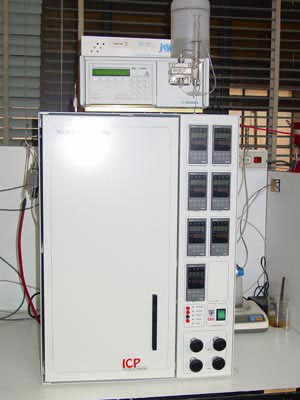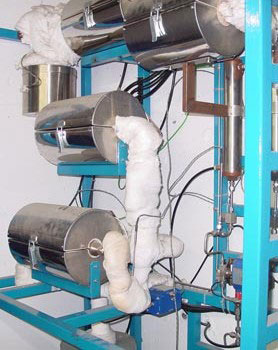WASTEWATER TREATMENT THROUGH HUMID OXIDATION
|
Description |

Continuous reactor under subcritical conditions with downward flow (TBR).
The Group of Catalysis and Separation Processes (CyPS) of the Department of Chemical Engineering of the Faculty of Chemical Sciences offers the purification of industrial waste water, particularly toxic and high organic content, by wet oxidation with discontinuous equipment in a pilot plant with and without catalysts.
The organic matter is converted to simpler organic compounds that are subsequently oxidized and converted to CO2 and H2O, without emission of NO, SO2, HCl, dioxins, furans, etc., thereby eliminating the toxicity of waste water.
The use of heterogeneous catalysts in wet oxidation, besides drastically decreasing the pressure and temperature conditions, is presented as a fast, efficient and clean method, due to the easy recovery of the catalyst.
|
How does it work |
In this process, which develops in liquid phase, the organic substances are degraded, to a greater or lesser extent, according to the conditions of pressure and temperature applied. Also influence the type of oxidant and its concentration.
It is carried out at high temperatures (70-350 ° C) and pressures (10-200 atm). A gaseous source of oxygen, preferably air, is usually used, since it is more economical. The solubility of oxygen in aqueous solutions is enhanced at high temperatures and pressures, which provides a high driving force for oxidation. It also enhances the diffusion of oxygen and organic compounds under these conditions. Thus, it happens that most of the contaminants are completely oxidized. High pressures are necessary to maintain the water in this liquid state. Water, in turn, is a suitable medium for the transmission of heat, and has the role of regulator of the heat, eliminating the excess of this by vaporization.
The wet oxidation process becomes thermally self-sustaining when the chemical oxygen demand (COD) of the treated water exceeds 20g / L, and if the COD of the food is high enough it can even become a process with net energy production.
The degree of oxidation is a function of temperature, oxygen partial pressure, residence time in the reactor, and the molecular structure of the contaminants considered. Complete oxidation would lead to the formation of CO2 and water, as well as an elimination of toxicity.
The use of catalysts in the wet oxidation process drastically reduces the pressure and temperature conditions applied for the oxidation of organic matter.
|
Advantages |
Wet oxidation is a technology that allows the disposal in waste water of organic compounds that are too diluted to apply the incineration or too concentrated to be subjected to biological treatment. In addition, in the case of using catalysts, the pressure and temperature conditions applied for the oxidation of organic matter are drastically reduced, making it a fast, efficient and clean method due to the easy recovery of the catalyst.
|
Where has it been developed |

Continuous reactor working in supercritical conditions.
The research team responsible for this technology has developed its work in the Laboratory of Basic Operations integrated in the Department of Chemical Engineering of the Faculty of Chemical Sciences.
The group has extensive research experience and has published numerous articles in international journals and doctoral theses, has developed research projects funded by the Spanish Administration and has experience in collaborations with both European and Spanish industries.
The research group has continuous and discontinuous reactors to perform wet oxidation with or without catalysts, both under subcritical and supercritical conditions. In addition, different analytical equipment such as gas chromatographs, liquids, masses, UV / Vis spectrophotometer, COD, COT, as well as equipment for the characterization of catalytic materials are available: FTIR, DRX, BET, TGA, TPD, Porosimeter, etc.
|
And also |
The group seeks partners from public bodies or private companies from sectors such as the food, chemical or petrochemical industry interested in implementing this technology.
The services that can be provided by the group range from the determination of the characteristic parameters of a residual water, until its purification. The group has the know-how and experience necessary to successfully develop the feasibility study and the application of technology to a specific case.
|
Contact |
|
© Office for the Transfer of Research Results – UCM |
|
PDF Downloads |
|
Classification |
|
Responsible Researcher |
Gabriel Ovejero Escudero: govejero@quim.ucm.es
Department: Chemical Engineering
Faculty: Chemical Sciences


